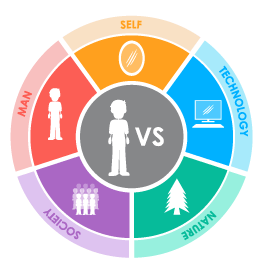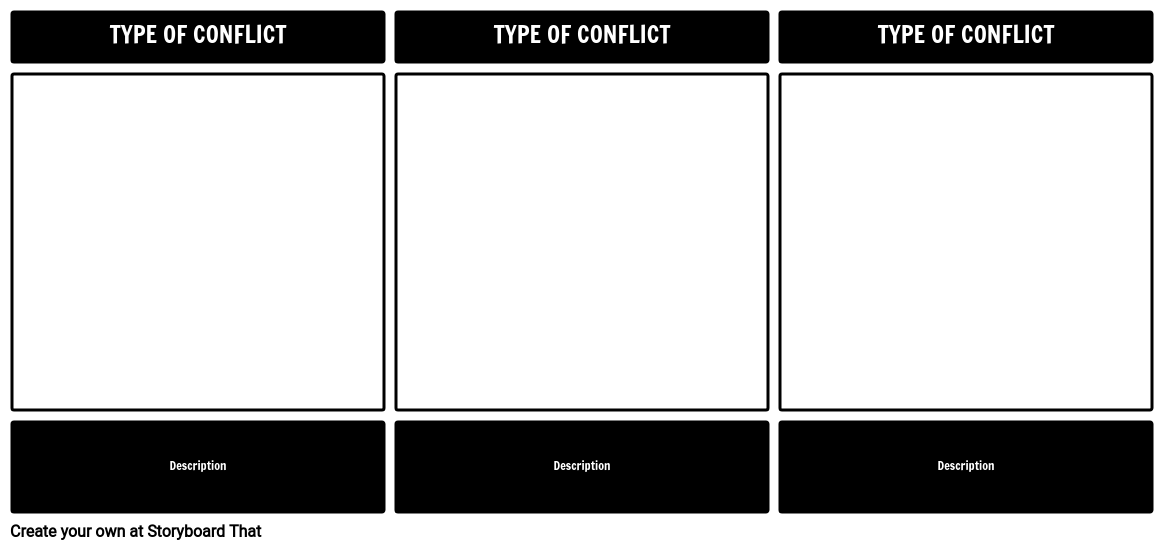Lesson Plan Overview
Storyboarding is an excellent way to focus on types of literary conflicts.
Having students create storyboards that show the cause and effect of different types of conflicts strengthens analytical thinking about literary concepts. Have your students choose an example of each literary conflict in Esperanza Rising and depict them using the Storyboard Creator. In the storyboard, an example of each conflict should be visually represented, along with an explanation of the scene, and how it fits the particular category of conflict.
Examples of Literary Conflict in Esperanza Rising
CHARACTER vs. MAN
Tio Luis causes a serious conflict for Esperanza and her mother when he demands that Mama marry him or else...When she refuses, Tio Luis burns down their house and vineyard.
CHARACTER vs. SELF
Esperanza struggles to go on when things get difficult. After Mama goes to the hospital, Esperanza cries every night and is not sure she has the inner strength to keep fighting to survive.
CHARACTER vs. NATURE
Nature is in conflict with Esperanza when a dust storm arises. The high winds and thick dust make it difficult to breathe and cause Mama to get sick with Valley Fever.
CHARACTER vs. SOCIETY
As a Mexican immigrant during the Great Depression, Esperanza, her family, and friends face prejudice from the white Americans. The Mexican company camps are poorly built and Mexican workers are often fired from jobs when white workers need the money.
Template and Class Instructions
(These instructions are completely customizable. After clicking "Copy Activity", update the instructions on the Edit Tab of the assignment.)
Student Instructions
Create a storyboard that shows at least three forms of literary conflict in Esperanza Rising.
- Identify conflicts in Esperanza Rising.
- Categorize each conflict as Character vs. Character, Character vs. Self, Character vs. Society, Character vs. Nature, or Character vs. Technology.
- Illustrate conflicts in the cells, using characters from the story.
- Write a short description of the conflict below the cell.
Lesson Plan Reference
Student Rubric
(You can also create your own on Quick Rubric.)
| Proficient | Emerging | Beginning | |
|---|---|---|---|
| Conflict Identification | Student identifies conflicts as directed and labels them accurately in their correct categories. | Student misidentifies one conflict or includes it in an incorrect category. | Student misidentifies two or more conflicts or includes them in incorrect categories. |
| Conflict Explanation | The storyboard text describes the specific example depicted, not just a general problem. The text clearly explains how the example reflects its particular type of conflict. | The storyboard text describes the specific example depicted, but may lack clarity. Text may fail to fully explain how the example reflects its particular type of conflict. | Storyboard is missing text or contains only partial and/or inaccurate information. |
| Storyboard Image and Effort | Student clearly shows effort to convey the setting, characters and specific scene of the book. The scene is clearly identifiable based on the graphic depiction. | Student attempts to convey the setting, characters, and specific scene through use of graphics, but the depiction may be confusing, disordered, or lack some detail. | Student does not clearly convey the setting, characters, and scene. |
| Spelling and Grammar | Student uses exemplary spelling and grammar. There are no errors. | Student makes one or two minor errors in spelling and grammar. | Student makes multiple errors in spelling and grammar. |
Lesson Plan Overview
Storyboarding is an excellent way to focus on types of literary conflicts.
Having students create storyboards that show the cause and effect of different types of conflicts strengthens analytical thinking about literary concepts. Have your students choose an example of each literary conflict in Esperanza Rising and depict them using the Storyboard Creator. In the storyboard, an example of each conflict should be visually represented, along with an explanation of the scene, and how it fits the particular category of conflict.
Examples of Literary Conflict in Esperanza Rising
CHARACTER vs. MAN
Tio Luis causes a serious conflict for Esperanza and her mother when he demands that Mama marry him or else...When she refuses, Tio Luis burns down their house and vineyard.
CHARACTER vs. SELF
Esperanza struggles to go on when things get difficult. After Mama goes to the hospital, Esperanza cries every night and is not sure she has the inner strength to keep fighting to survive.
CHARACTER vs. NATURE
Nature is in conflict with Esperanza when a dust storm arises. The high winds and thick dust make it difficult to breathe and cause Mama to get sick with Valley Fever.
CHARACTER vs. SOCIETY
As a Mexican immigrant during the Great Depression, Esperanza, her family, and friends face prejudice from the white Americans. The Mexican company camps are poorly built and Mexican workers are often fired from jobs when white workers need the money.
Template and Class Instructions
(These instructions are completely customizable. After clicking "Copy Activity", update the instructions on the Edit Tab of the assignment.)
Student Instructions
Create a storyboard that shows at least three forms of literary conflict in Esperanza Rising.
- Identify conflicts in Esperanza Rising.
- Categorize each conflict as Character vs. Character, Character vs. Self, Character vs. Society, Character vs. Nature, or Character vs. Technology.
- Illustrate conflicts in the cells, using characters from the story.
- Write a short description of the conflict below the cell.
Lesson Plan Reference
Student Rubric
(You can also create your own on Quick Rubric.)
| Proficient | Emerging | Beginning | |
|---|---|---|---|
| Conflict Identification | Student identifies conflicts as directed and labels them accurately in their correct categories. | Student misidentifies one conflict or includes it in an incorrect category. | Student misidentifies two or more conflicts or includes them in incorrect categories. |
| Conflict Explanation | The storyboard text describes the specific example depicted, not just a general problem. The text clearly explains how the example reflects its particular type of conflict. | The storyboard text describes the specific example depicted, but may lack clarity. Text may fail to fully explain how the example reflects its particular type of conflict. | Storyboard is missing text or contains only partial and/or inaccurate information. |
| Storyboard Image and Effort | Student clearly shows effort to convey the setting, characters and specific scene of the book. The scene is clearly identifiable based on the graphic depiction. | Student attempts to convey the setting, characters, and specific scene through use of graphics, but the depiction may be confusing, disordered, or lack some detail. | Student does not clearly convey the setting, characters, and scene. |
| Spelling and Grammar | Student uses exemplary spelling and grammar. There are no errors. | Student makes one or two minor errors in spelling and grammar. | Student makes multiple errors in spelling and grammar. |
How Tos about Literary Conflict in Esperanza Rising
Incorporate Literary Conflict Discussions in Group Work
Encourage students to work together in small groups to analyze different types of conflict. By sharing perspectives, students develop deeper understanding and learn to appreciate varied interpretations of conflict in literature.
Assign Each Group a Conflict Type
Assign each group one specific conflict type (such as Character vs. Self or Character vs. Society) from Esperanza Rising to focus on. This helps students dive deeper and become 'experts' in that area, making group presentations more meaningful.
Guide Groups to Identify and Illustrate Key Scenes
Ask each group to find a relevant scene in the novel that fits their assigned conflict type. Have them create a storyboard cell or visual to illustrate the moment, reinforcing text-to-visual connections.
Facilitate Group Presentations and Peer Feedback
Invite each group to present their scene and explanation to the class. Encourage classmates to ask questions or provide feedback, which builds critical thinking and respectful discussion skills.
Reflect as a Class on Conflict Types and Their Impact
Lead a brief whole-class reflection about how each conflict type affected the characters and plot. This helps students connect literary concepts to character development and story outcomes.
Frequently Asked Questions about Literary Conflict in Esperanza Rising
What are the main types of literary conflict in Esperanza Rising?
Esperanza Rising features several types of literary conflict, including Character vs. Character (Esperanza vs. Tio Luis), Character vs. Self (Esperanza’s internal struggles), Character vs. Nature (the dust storm and its aftermath), and Character vs. Society (facing prejudice as immigrants).
How can I teach literary conflict using Esperanza Rising?
You can teach literary conflict with Esperanza Rising by having students identify examples from the text and create storyboards that visually represent each conflict type, along with short explanations connecting the scenes to specific conflict categories.
What is an example of Character vs. Society in Esperanza Rising?
An example of Character vs. Society is when Esperanza and her family face discrimination as Mexican immigrants in the U.S. during the Great Depression, experiencing poor living conditions and job insecurity due to prejudice.
Why is storyboarding effective for analyzing conflict in literature?
Storyboarding helps students break down complex literary conflicts by allowing them to visualize scenes, clarify cause and effect, and deepen their understanding through creative representation and explanation.
What storyboard instructions work best for teaching Esperanza Rising conflicts?
Effective instructions include: select at least three conflict types from the novel, illustrate each scene using characters, label the conflict category, and write a brief description explaining how the scene fits that conflict type.
More Storyboard That Activities
Esperanza Rising
Testimonials

“By using the product, they were so excited and they learned so much...”–K-5 Librarian and Instructinal Technology Teacher

“I'm doing a Napoleon timeline and I'm having [students] determine whether or not Napoleon was a good guy or a bad guy or somewhere in between.”–History and Special Ed Teacher

“Students get to be creative with Storyboard That and there's so many visuals for them to pick from... It makes it really accessible for all students in the class.”–Third Grade Teacher
© 2026 - Clever Prototypes, LLC - All rights reserved.
StoryboardThat is a trademark of Clever Prototypes, LLC, and Registered in U.S. Patent and Trademark Office








